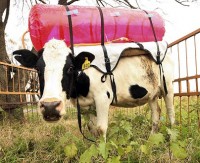By Lawrence Solomon, Financial Post
Planet Earth is on a roll! GPP is way up. NPP is way up. To the surprise of those who have been bearish on the planet, the data shows global production has been steadily climbing to record levels, ones not seen since these measurements began. GPP is Gross Primary Production, a measure of the daily output of the global biosphere—the amount of new plant matter on land. NPP is Net Primary Production, an annual tally of the globe’s production. Biomass is booming. The planet is the greenest it’s been in decades, perhaps in centuries.
Until the 1980s, ecologists had no way to systematically track growth in plant matter in every corner of the Earth—the best they could do was analyze small plots of one-tenth of a hectare or less. The notion of continuously tracking global production to discover the true state of the globe’s biota was not even considered. Then, in the 1980s, ecologists realized that satellites could track production, and enlisted NASA to collect the data. For the first time, ecologists did not need to rely on rough estimates or anecdotal evidence of the health of the ecology: They could objectively measure the land’s output and soon did—on a daily basis and down to the last kilometre.
The results surprised Steven Running of the University of Montana and Ramakrishna Nemani of NASA, scientists involved in analyzing the NASA data. They found that over a period of almost two decades, the Earth as a whole became more bountiful by a whopping 6.2%. About 25% of the Earth’s vegetated landmass—almost 110 million square kilometres—enjoyed significant increases and only 7% showed significant declines. When the satellite data zooms in, it finds that each square metre of land, on average, now produces almost 500 grams of greenery per year.
Why the increase? Their 2004 study, and other more recent ones, point to the warming of the planet and the presence of CO2, a gas indispensable to plant life. Read more why that may be coming to an end and why any efforts to sequester the atmospheric carbon, mistakenly called a pollutant by alarmists and environmentalists may have very costly unintended consequences here.
By Jim Sims, Senior Counsellor, Americans For American Energy
Our rapidly growing national pro-consumer grassroots network is going to shake the halls of Congress next week in its demand for more American energy. Led by the Congress of Racial Equality, a coalition of leaders from the African American, civil rights, agriculture, Christian, senior citizen and consumer rights communities will stage a “Stop The War On The Poor” Rally and press conference on the U.S. Capitol Grounds next Tuesday, July 15 at 2 p.m. You can see details on this event here.

We expect a few dozen Members of Congress—both Democrats and Republicans—will participate in next Tuesday’s rally. This rally will kick off a large, highly integrated national campaign that will activate several million citizens by the end of this year to push for more domestic energy production. You can see a brief summary of the national “Stop The War on the Poor” campaign plan here.
These leaders and their large constituencies are rallying behind the message of Roy Innis, Chairman of the Congress of Racial Equality, who contends in a new book ("Energy Keepers, Energy Killers") that federal policies that raise the cost of energy disproportionately hurt the poor because low-income families must devote a larger portion of their income to energy costs than middle- or high-income families. These policies amount to a de facto “War On The Poor,” which is fueling consumer anger and rapid grassroots activation on a national scale.
No industry or business representatives will be on the stage next Tuesday—only grassroots, consumer and community leaders. However, you are encouraged to attend the event and be a part of the crowd. See more on organization here.
By Rupert Neate , UK Telegraph
Scientists are examining cow farts and burps in a novel bid to combat global warming. Experts said the slow digestive system of cows makes them a key producer of methane, a potent greenhouse gas that gets far less public attention than carbon dioxide. In a bid to understand the impact of the wind produced by cows on global warming, scientists collected gas from their stomachs in plastic tanks attached to their backs.

Argentine scientists are strapping plastic tanks to the backs of cows (Reuters). Larger image here.
The Argentine researchers discovered methane from cows accounts for more than 30 per cent of the country’s total greenhouse emissions. As one of the world’s biggest beef producers, Argentina has more than 55 million cows grazing in its famed Pampas grasslands. Guillermo Berra, a researcher at the National Institute of Agricultural Technology, said every cow produces between 8000 to 1,000 litres of emissions every day.
Methane, which is also released from landfills, coal mines and leaking gas pipes, is 23 times more effective at trapping heat in the atmosphere than carbon dioxide. Scientists are now carrying out trials of new diets designed to improve cows’s digestion and hopefully reduce global warming. Silvia Valtorta, of the National Council of Scientific and Technical Investigations, said that by feeding cows clover and alfalfa instead of grain “you can reduce methane emissions by 25 percent”. Read full story here.


